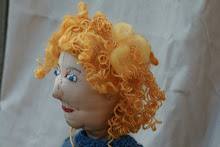A few days ago, my friend V sent me this
link to a video about Free-motion quilting. As part of the preparation it mentions using a spray adhesive to baste the quilt sandwich together--no surprises there. I've used spray basting before, and didn't love it. The surprise came when I realised the basting was being done on a wall. I was intrigued. When I saw how easy it looked in the video, I went beyond intrigued. To understand the attraction, you have to know that quilts are traditionally basted on a horizontal surface. And the surface needs to be at least as big as the quilt. The trouble with horizontal surfaces at my place is that they have a strong tendency to acquire a layer or three of
stuff--useful, necessary and unrelenting
stuff. What's more, a standard bed quilt--even a single--is wider than my large table. And basting on a horizontal surface involves lots of awkward bending and reaching. When I watched the follow-up
video, my excitement turned to disappointment. I realised that this technique requires, not just a dedicated wall, but one covered in a substance that will easily hold pins--and strong enough to carry the entire weight of the quilt. The tutor on the video used a wall covered in foam ceiling tiles. I wasn't about to recover a large piece of wall in ceiling tiles just to see if the idea would work.
I put the idea aside and went on with my plans to visit the large table at the Neighbourhood House whenever I need to baste a quilt. But while I was getting on with something else, my brain started making connections, until . . . ah ha! A solution came to mind:
- I've long liked the idea of having a design wall--a space to pin up fabric and quilt blocks while deciding about arrangement, colour balance etc. Sometimes I've pinned a large sheet over an area of my living room wall--temporary, but effective.
- Quite a while ago I acquired a large quantity of white cotton drill fabric, I'd never got around to using it--so it became part of the clutter in my sewing room;
- If I could make a stable enough surface out of my white drill fabric I could have a design wall and a basting wall all in one.
- Two rod pockets, a curtain rod and hooks to hold the fabric at the top and a 2 metre length of timber to weigh down the bottom had me nearly there.
- My rod-pocket curtain idea made a good design wall. To stabilise it enough to use for quilt basting, I used drawing pins to attach the edges of the fabric directly to the plaster wall.
Here it is on a trial run with one of the baby bunny rugs I mentioned in an earlier post: 
So far, so good! My design/basting wall is just about 2 metres wide and 2.3 metres high--I've never made a quilt bigger than that and I could push out the width a bit more if needs be. The "spray basting on a wall" technique seems to be as easy and effective as it looks in the video. I was worried that the tutor's competence in this reflected years of skill development--I'm sure her free-motion quilting does, but the basting part is just easy. I don't think I'll miss that particular patch of wall in my living room--I only had to move one small quilt to make room for it. I think I'm onto a good thing. I now have two baby rugs ready for binding and a smile on my face. Oh, and I forgot to mention, I already had all the necessary hardware in the house!



2 comments:
neato idea. is the pic the right way up? I am having trouble orienting it from the description... is that the wood at the left?
how does the first piece stay up? the one I had seen had used a flannel sheet so the fabrics would 'stick' but drill doesn't seem that grippy.
The photo is oriented correctly. The glimpse of wood you can see on the left is the edge of my noticeboard--ignore it. The wood I mentioned in the post is inside a rod pocket at floor level. The first layer stays up with pins. I could never get even my flannel sheet to hold one layer of fabric, let alone two, so it doesn't matter that the drill isn't grippy, it's strong enough to hold the weight of a whole quilt.
Post a Comment